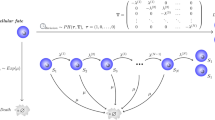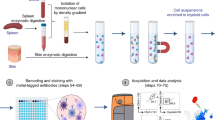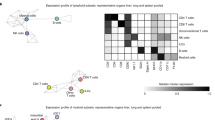Abstract
DESPITE their suspected heterogeneity in origin, life span and precise function, lymphocytes are usually considered to be a single group because of the rather negative morphological criteria available. One morphological division of lymphocytes into immature (large and medium) and mature (small) cells is physiologically relevant, because the larger cells represent a population which synthesizes DNA and which divides, while the smaller cells are not usually engaged in DNA synthesis. Morphological criteria are as yet, however, inadequate to make possible identification of the classes of lymphocytes which are now studied by such functional tests as the ability to respond to antigen and to produce a colony of cells which form antibody, the ability to produce various classes of antibody or the ability to initiate a graft-versus-host reaction. This communication suggests equilibrium density gradient centrifugation as a technique which may prove valuable, not only in defining lymphocyte classes, but also in separating them from each other.
This is a preview of subscription content, access via your institution
Access options
Subscribe to this journal
Receive 51 print issues and online access
$199.00 per year
only $3.90 per issue
Buy this article
- Purchase on Springer Link
- Instant access to full article PDF
Prices may be subject to local taxes which are calculated during checkout
Similar content being viewed by others
References
Shortman, K., Aust. J. Exp. Biol. Med. Sci. (in the press).
Jerne, N. K., Norden, A. A., and Henry, C., in Cell Bound Antibodies (edit. by Amos, B., and Koprowski, H.), 109 (Wistar Institute Press, Philadelphia, USA, 1963).
Cunningham, A. J., Smith, J. B., and Mercer, E. H., J. Exp. Med., 124, 701 (1966).
Harris, T. N., Hummeler, K., and Harris, S., J. Exp. Med., 123, 161 (1966).
Hummeler, K., Harris, T. N., Tomassini, N., Hechtel, M., and Farber, M. B., J. Exp. Med., 124, 255 (1966).
Szenberg, A., and Shortman, K., Ann. NY Acad. Sci., 129, 310 (1966).
Burnet, F. M., and Boyer, G. S., J. Pathol. Bacteriol., 81, 141 (1961).
Haskill, J. S., (following communication).
Author information
Authors and Affiliations
Rights and permissions
About this article
Cite this article
SHORTMAN, K., HASKILL, J., SZENBERG, A. et al. Density Distribution Analysis of Lymphocyte Populations. Nature 216, 1227–1229 (1967). https://doi.org/10.1038/2161227a0
Received:
Published:
Issue Date:
DOI: https://doi.org/10.1038/2161227a0
This article is cited by
Comments
By submitting a comment you agree to abide by our Terms and Community Guidelines. If you find something abusive or that does not comply with our terms or guidelines please flag it as inappropriate.



